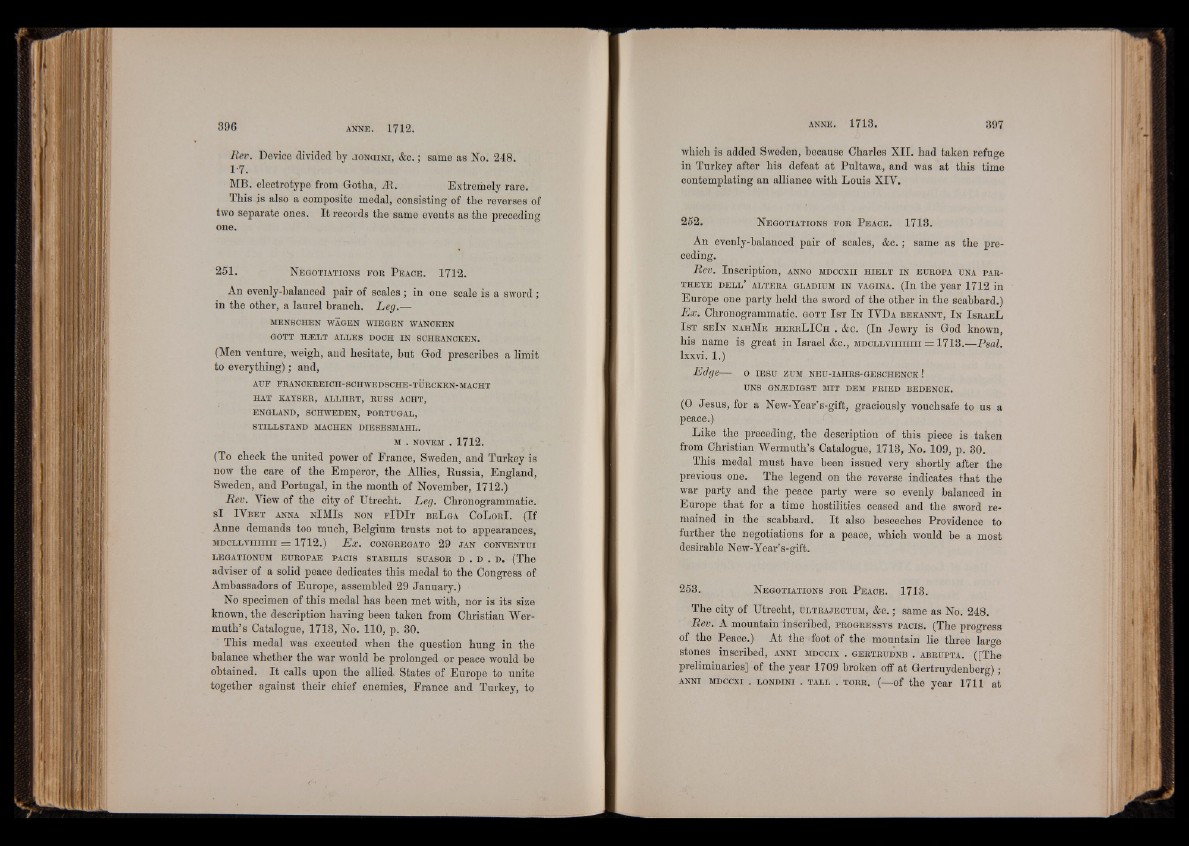
Rev. Device divided by jo n c i in i , &c. ; same as No. 248.
1-7.
MB. electrotype from Gotba, 2R. Extremely rare.
This is also a composite medal, consisting of the reverses of
two separate ones. It records the same events as the preceding
one.
251. N e g o t ia t io n s f o r P e a c e . 1712.
An evenly-balanced pair of scales ; in one scale is a sword ;
in the other, a laurel branch. Leg.—
MENSCHEN WÄGEN WIEGEN WANCKEN
GOTT HiELT ALLES DOCH IN SCHRANCKEN.
(Men venture, weigh, and hesitate, but God prescribes a limit
to everything); and,
AUF FRANCKREICH-SCHWEDSCHE-TÜRCKEN-MACHT
HAT KAYSER, ALLIIRT, RUSS ACHT,
ENGLAND, SCHWEDEN, PORTUGAL,
STILLSTAND MACHEN DIESESMAHL.
M . NOVEM . 1712.
(To check the united power of France, Sweden, and Turkey is
now the care of the Emperor, the Allies, Russia, England,
Sweden, and Portugal, in the month of November, 1712.)
Rev. View of the city of Utrecht. Leg. Chronogrammatic.
s i I V b e t a n n a n IM I s n o n f I D I t b e L g a C o L o r I . (If
Anne demands too much, Belgium trusts not to appearances,
M D C L L v nm n =-“1712.) Ex. c o n g r e g a t o 29 j a n c o n v e n t u i
LEGATIONUM EUROPAE PACIS STABILIS SUASOR D . D . D. (The
adviser of a solid peace dedicates this medal to the Congress of
Ambassadors of Europe, assembled 29 January.)
No specimen of this medal has been met with, nor is its size
known, the description having been taken from Christian Wer-
muth’s Catalogue, 1713, No. 110, p. 30.
This medal was executed when the question hung in the
balance whether the war would be prolonged or peace would be
obtained. It calls upon the allied» States of Europe to unite
together against their chief enemies, France and Turkey, to
which is added Sweden, because Charles XII. had taken refuge
in Turkey after his defeat at Pultawa, and was at this time
contemplating an alliance with Louis XIV.
252. N e g o t ia t io n s f o r P e a c e . 1713.
An evenly-balanced pair of scales, &c.; same as the preceding.
Rev. Inscription, anno m d c c x ii h ie l t in eu r o pa una pa r -
t h e y e d e l l ’ a l t e r a g la d ium in v a g in a . (In the year 1712 in
Europe one party held the sword of the other in the scabbard.)
Ex. Chronogrammatic. g o t t 1 st I n IVDa b ek a n n t , I n I sr a eL
1 s t s e I n n a hM e h e r r L I C h . &c. (In Jewry is God known,
his name is great in Israel &c., m d c l l v i i i i i i i i = 1713.—Psal.
lxxvi. 1.)
Edge— o ie s u zum n e u -ia h r s -g e s c h e n c k !
UNS GNA3DIGST MIT DEM FRIED BEDENCK.
(0 Jesus, for a New-Year’s-gift, graciously vouchsafe to us a
peace.)
Like the preceding, the description of this piece is taken
from Christian Wermuth’s Catalogue, 1713, No. 109, p. 30.
This medal must have been issued very shortly after the
previous one. The legend on the reverse indicates that the
war party and the peace party were so evenly balanced in
Europe that for a time hostilities ceased and the sword remained
in the scabbard. It also beseeches Providence to
further the negotiations for a peace, which would be a most
desirable New-Year’s-gift.
253. N e g o t ia t io n s f o r P e a c e . 1713.
The city of Utrecht, tfLTRAJECTUM, &c.; same as No. 248.
Rev. A mountain inscribed, pr o g r e s sv s pa c is . (The progress
of the Peace.) At theYoot of the mountain lie three large
stones inscribed, a n n i m dc c ix . g e r t r u d n b . a b r u p t a . ([The
preliminaries] of the year 1709 broken off at Gertruydenberg) ;
a n n i m dc cxi . l o n d in i . ta l l . t o r r . (—of the year 1711 at